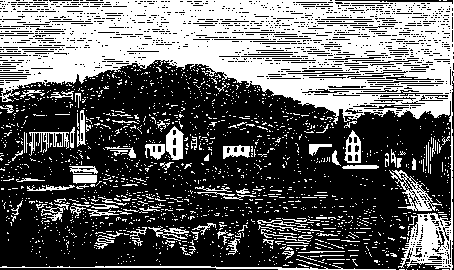

We end this Journey with Colebrook, on the Massachusetts border. Proprietors' rights were sold by Hartford, under the joint agreement with Windsor. The name was taken from Colebrook in Devonshire. Settlement began in 1765, and the town was incorporated in 1779. The town is a mountainous region of great natural beauty, with a considerable summer colony.
Going north on the attractive R. 183, we pass through Colebrook Village, where there are a number of 18th century houses. The Timothy Rockwell house opposite the Congregational Church was built in 1793, and the Samuel Rockwell House, a little farther on our left, in 1767. The Parsonage on our right beyond the turn is of interest. Sandy Brook Rd. to our right leads in 3/4 mile to the picturesque Beulah Falls. On our left, as we leave the village, are the remains of an old iron furnace. About 1 mile north, Mt. Pisgah lies to the right, with a good view of the surrounding country. On the west is the Jonathan Edwards House, built about 1767, and occupied by Jonathan Edwards, Jr., son of the famous divine, who the first minister of the church (1795-99) leaving to become president of Union College. At North Colebrook there are two good houses: The Carrington Phelps House on our left, and the Dr. Jesse Carrington House of 1804 a little farther on our right. R. 183 continues north to Sandisfield, Mass. On U.S. 8, a side road to Robertsville takes us east to the picturesque Tunxis Falls, in Sandy Brook, near its junction with Still River. At the union of the streams are the foundations of Richard Smith's Iron Furnace, erected about 1770 by a Boston merchant and shipbuilder, the 'iron prince" of that day. He had acquired the blast furnace at Lakeville, but opened another plant here, probably because of the large charcoal supply. Permission was given by the authorities to raise the level of Highland Lake, to supply more power, and a convenient road laid out by the Colony up the Farmington River to the Furnace. Ore was brought from Salisbury in saddle-bags or by oxteam, and the pig iron transported to Boston. Though the owner was detained in England by business during the Revolution, the Furnace rendered great service, and continued in operation until 1810.
The rough road which turns northwest from U.S. 8 up *Sandy Brook is one of the most beautiful in Connecticut. The hemlock-draped ravine is often deep below the road. The original spelling was Sandys Brook, named like Sandisfield at the headwaters from Samuel Sandys of Boston. U.S. 8 continues its scenic course to the Farmington and through the village of Colebrook River to Massachusetts.